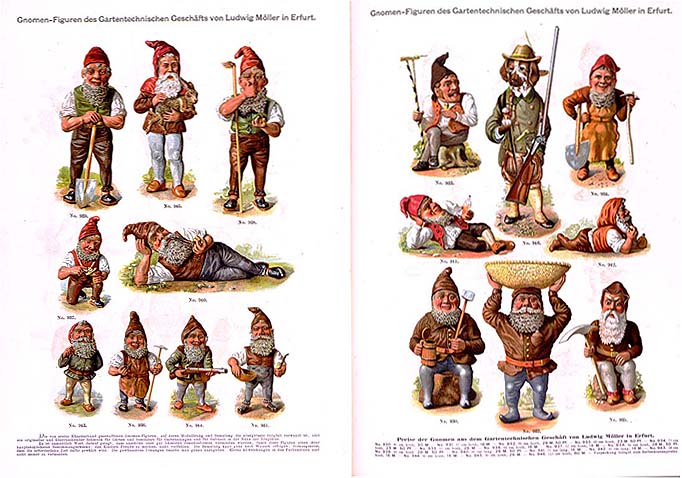Hardly any garden accessory divides the hobby gardening community as much as the garden gnome. Either you love the small, colorful gnomes or you hate them. Nevertheless, it is impossible to imagine garden culture without them. They populate front gardens, allotment garden colonies, farms, ponds and greet you when you look over the neighbor’s fence. But where do the red pointed caps actually come from and what exactly distinguishes them? Our garden experts got to the bottom of these questions.
Contents
- 1 The history of the garden gnome
- 2 The garden gnome in Europe
- 3 The garden gnome
- 4 The classic garden gnomes
- 5 Garden gnomes during leisure and hobby activities
- 6 Are dwarfs offensive?
- 7 Garden gnomes – fake or not
- 8 The most popular gnome models
- 9 What do I have to consider when setting them up?
- 10 Conclusion
- 11 Author
The history of the garden gnome
Gnomes and their stories have been known since time immemorial. As early as the Middle Ages, they served as models for sculptors and artists. The first images of gnomes resembling the classic garden gnome of today appeared in the famous Grottenbahn in the Vienna Prater, a precursor of fairy tale parks. Here, the dwarfs first served to illustrate stories and fairy tales to visitors in 1897. Other fairy tale parks and designs of dwarfs followed, some of which can still be admired today. The following catalog excerpt from Ludwig Möller’s horticultural store in Thuringia – the state that, according to various sources, is considered the birthplace of the little clay gnomes – also dates from about the same time.
In Gräfenroda, which is located there, the first Zipfel caps are said to have been produced in the factories of Philipp Griebel and August Heissner between 1872 and 1874. However, this did not happen in the trivialized form that we know today: The gnomes at that time were rather characterized by serious facial expressions and their advancing age.
The garden gnome in Europe
Where exactly the garden gnome originated in Europe is still unclear. The first records of clay gnomes date back to the Baroque period (1575 – 1770). From the Biedermeier period in the 19th century, garden gnomes gained new popularity in Europe. For the citizens of that time, the small clay gnomes were an ideal fit for the front and allotment gardens. In Goethe’s epic poem “Hermann and Dorothea” from 1797, the gnomes found such an impressive mention that travelers even visited regions with many garden gnomes especially to admire them.
The garden gnome
Garden gnomes symbolize classic values such as diligence, reliability and seriousness. They stand for tradition worldwide. Opponents of the colorful garden decoration see the pointed hats as a symbol of narrow-mindedness, philistinism and kitsch. Since the beginning of the 19th century, the little gnomes have been part of the classic European garden image and have already given rise to many a passionate neighborhood dispute.
In the meantime, a large number of gnome variations are available on the market. What all gnome caps have in common is the classic material of fired clay and a story they tell:
The classic garden gnomes
Classic garden gnomes are characterized by work and support the hardworking gardener. They symbolize their dedication, for example, with a wheelbarrow, a spade or other utensils. In technical jargon they bear the title “Nanus laborans”. Particularly practical are gnomes, which, in addition to decorative purposes, can also be used for functional purposes.
For example, they hold mining lamps in their hands and thus provide light in the plot, carry flower pots and thus provide space for smaller plants, or are involved in garden watering by holding a hose or watering can in their hands. For some specimens, however, gardening is a bit more modern. For example, some garden gnomes use a lawn mower to tend to the green areas and thus, in the best case, reflect the lawn splendor of their owner. In addition to gardening, some gnomes also do handicrafts. For example, they climb up rain gutters to keep roof drainage intact or are equipped with a hatchet to do woodworking.
Garden gnomes during leisure and hobby activities
After work is done, a garden gnome also enjoys its well-deserved evening off: it does this, for example, in the company of chickens, rabbits, guinea pigs and co. It either carries these lovingly in its arms or watches them in their outdoor enclosures and cages. But also the BBQ trend has meanwhile arrived at the garden gnome: Meat and vegetables are prepared together on the kettle grill to end the evening in a cozy atmosphere.
If the wretch with the pointed cap is not to be found in the garden at home, he may be enjoying himself on a camping trip. At the seaside with sunglasses, playing music with different instruments or reading in the tent, he allows himself a little time out from the daily work routine at home. Back from vacation, the modern dwarf likes to show off his photographic exploits on his cell phone. But he also knows how to keep himself busy at home: Whether fishing at the garden pond or swinging on a swing, he always wears that well-known hearty laugh on his face. In the evening, many a gnome may also enjoy a glass of wine. This shows that even the culture of wine is not immune to the garden dwellers wearing pointed hats.
Are dwarfs offensive?
The same applies to the so-called anti dwarves. They lie stabbed in the flowerbed, crawl out of the grass as a zombie or present themselves in obscene gestures.

However, setting up such gnomes can lead to neighborhood disputes if the surrounding residents feel disturbed. So you should make sure beforehand whether your surroundings will take the anti-gnomes with as much humor as you do.
Garden gnomes – fake or not
According to him, a real garden gnome wears a red cap and a green apron. This would be due to the Battle of Mikaea, 341 BC, in which green and red gnomes hit each other on the caps. Three days later, they called a “truce” and finally agreed on the outfit we know today. Another important characteristic, according to Friedmann, is the size of the dwarf: it should not be more than 68 centimeters. In addition, the material also plays a decisive role: plastic, plaster and Co. speak rather for mass-produced goods, which in his opinion only produces soulless dwarfs. The genuine garden gnome is made of terracotta and was lovingly handcrafted. Last but not least, gender also plays a decisive role in authenticity: the real garden gnome is male! Women, on the other hand, are rather frowned upon in the gnome world, according to Friedmann.
The most popular gnome models
In addition to the classic models with beard and pointed hat, dwarf-free variations are also enjoying increasing popularity.
As can be seen in the chart, prices are somewhat lower, especially in the winter months: In January 2017 (when demand was at its lowest), the average price for a garden gnome was 36.09 euros, and you also had to pay less than 50 euros for a garden gnome in November and December of the same year. In contrast, the warm months of June and September 2017 were particularly expensive. Here you had to reckon with an average of around 60 euros each. However, March 2018 was the top month on the price scale, with just under 75 euros spent on a little gnome during this period – around 20 euros or around 25 percent more than in January of the same year. Conversely, this means: If you buy at the right time, you can save a few euros – and perhaps adopt a second gnome.
The garden gnome in the jurisdiction
Hardly any garden accessory offers the jurisdiction so much content and judgments as the garden gnomes. Interesting are therefore above all the questions:
What do I have to consider when setting them up?
Which gnomes am I not allowed to put up?
In general, as a homeowner, you are allowed to put up as many garden gnome variations as you like. However, if the area is visible to the public (or neighbors), offensive gnomes may cause problems. In a legal dispute in Grünstadt, obscene anti-dwarfs have even been banned by the courts (file number: 2a C 334/9). But even too high a number could under certain circumstances lead to a ban on the garden gnomes. Judges in Hamburg, for example, have ruled that a large mass of garden gnomes in a residential complex can deter potential buyers. Therefore, a gnome lover had to visibly reduce his stock by many specimens.
“Equality” is in, but not with garden gnomes. Here, the two-tier society prevails: classic garden gnomes are considered cultural assets worthy of protection, while more modern anti- and recreational gnomes can be labeled a nuisance and sued away from a neighbor’s front yard by court order. So if you’re thinking of letting the latter move in, make sure you get your neighbor’s blessing first.
Conclusion
Garden gnomes not only have a long tradition, but also prove that the imagination and creativity of adults are not stuck in their infancy. Whether classic worker gnome or modern leisure gnome – almost all tastes and preferences can be found in a variety of variations. Politician gnomes, for example, can stand for humor or reflect a political worldview. Hard-working gnomes usually adorn a classic, well-kept front garden, while leisure gnomes may betray the preferences of their owners. In times when data protection and privacy play an increasingly important role, even seemingly harmless garden gnomes can give rise to a great deal of speculation, especially if their placement ends up in court. Anti-gnomes in particular can cause displeasure in the home environment due to their provocative appearance and heat up tempers. But before the neighborhood breaks up over a clay gnome, you should think about an “arbitrator gnome”. In the best case, you will create a good compromise and perhaps even offer space to find a common hobby.
They are not usually offensive, unless you get one doing an offensive gesture, but with a normal gnome you will have no problems.


